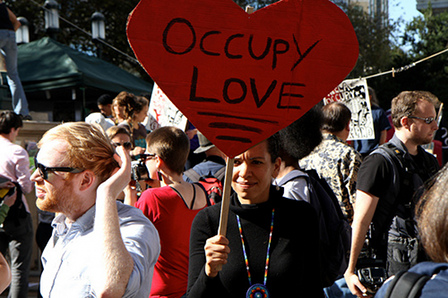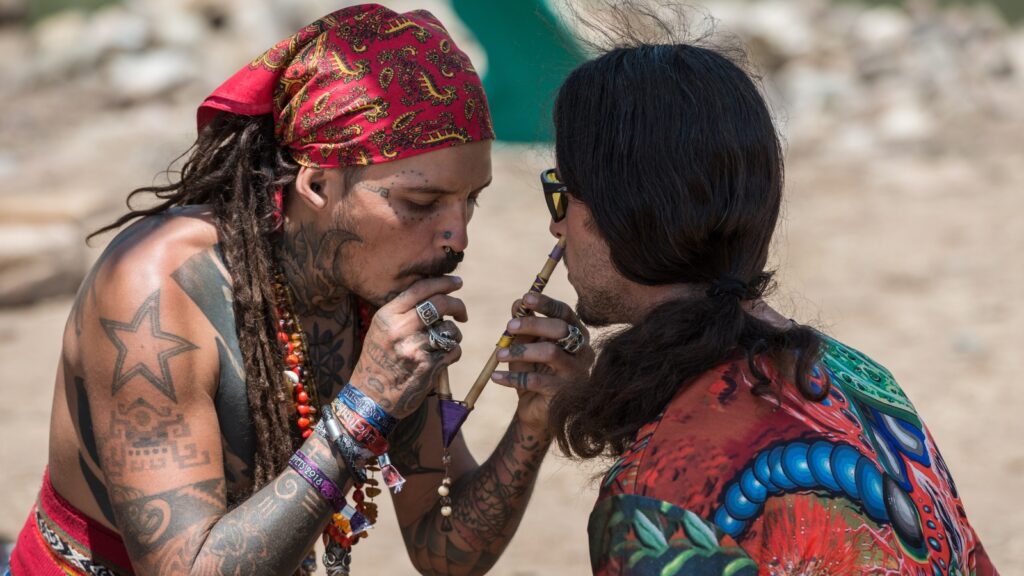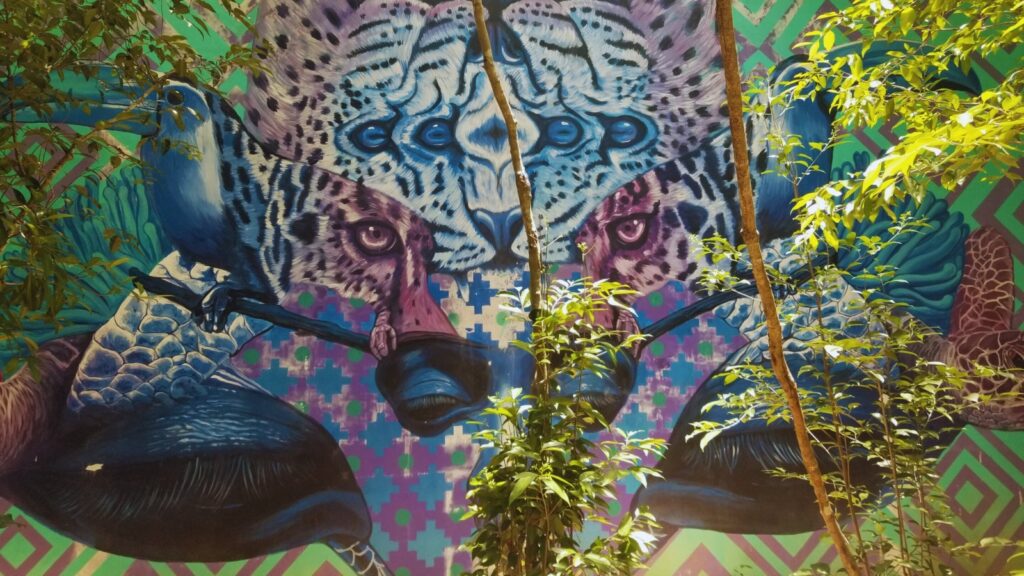Last year in May or June I realized that my political views were not quite what they used to be. It occurred to me that the words "Revolutions + justice" on my facebook profile were no longer adequate to what I felt was my politics. It occurred to me that love was a crucial element of politics, and I proceeded to add "Love" before "revolutions + justice". It felt like a radical act.
Love + Revolutions + Justice
On the night of October 25, in Oakland, I lit tealights and placed them on our front and back porch stairs with two of my housemates. It was Diwali already in India, and I was supposed to have risen early the next morning to join my mother and brother over skype as they performed the diwali havan. In all the years I have been living away, it was the first time we would be celebrating together, via technology, a festival that holds special meaning for my family. It was also the infamous night when Occupy Oakland was tear-gassed.
Earlier that morning, between 2am and 5am, the police had raided the camp at the Frank Ogawa/Oscar Grant Plaza. The Occupy Oakland text alert had sent out message after message as the raid proceeded; I had read them upon waking up and this is how I had received them: Heavy police presence. Raid is imminent. / Raid is confirmed. / Please wake up friends and come help defend! / Please come! / Please come! / Please come! Like sharp blows, like pleas ignored, like help not given. There had been over a hundred arrests before dawn.
By evening, people were back on the streets. A short while after lighting the tealights, we started hearing the helicopters. Text messages reported that the police were using tear gas upon the people. For a while, we tried to ignore the sound of the helicopters and the texts. I changed my clothes and got into bed, but could not sleep. It seemed as though the pain in my heart was growing and growing.
What can one do during a revolution? What can one do to help a revolution along? My housemates and I decided to go to the plaza with a bag full of rags and vinegar, which we naïvely hoped to hand in to the protestors so they could protect their faces. Of course, when we got there, we did not find a discrete group of "protestors" we could just hand over these things to. Instead, we found hundreds of people milling about, standing about, while the police in riot-gear barricaded the plaza from all directions. And I found two persons sitting across the barricades and quietly looking at the police. This felt so powerful that I joined them, and once I was sitting cross-legged, it seemed natural to begin meditating. When I opened my eyes, at least a dozen other people had joined us in the meditation.
The story of the night does not end here. At some point, there was a commotion in the crowd. One of the protestors had hurled abuses at the police, and he was quietly but firmly asked by the others to back out. Someone with a megaphone suggested individuals come forward and assure the police that most of the people present stood for non-violence. It suddenly struck me that I wanted to go up to the megaphone and say "I love you" to the police. I went, quavering, wondering if people would think this was inane and, as I took the horn in my hand, there was a light explosion a few feet to my right — firecracker thrown by a protestor? flash grenade thrown by a cop? — followed almost immediately by a tear gas canister fired at the crowd.
Even as I was running, even as I found my housemates and we found a safe spot and quickly doused rags with vinegar and put them against our burning eyes and nose, I found myself thinking, "Wow, that was quite a coincidence." Not then, but a while later, after the bravehearts, the largehearts, of Oakland were back in front of the barricades speaking about non-violence, I did go up to the megaphone and say "I love you" to the police and to all the people present. And people around me said to me, "Thank you for saying that."
Collective Unconscious as Intelligence
How do we read the synchronicity between my attempted speaking of love and the firing of tear gas that momentarily blocked it? Was it a challenge the universe was throwing in my direction: could I, even in the face of violence, hold love in my heart? If so, I have reasons to suspect that this "I" that I speak of is not just a personal "I". My "I love you" came before I knew that love had become a meme in the Occupy movement, that meditations were a part of the regular schedule of the Occupy Oakland camp, that inter-meditational sits were being organized as a way of being present at Occupy San Francisco by several mindfulness-based communities coming together. My "I love you" came, I believe, from a collective mind.
C.G. Jung conceptualized the collective unconscious, a part of the psyche that exists beyond the level of the personal: "The collective unconscious is common to all; it is the foundation of what the ancients called the 'sympathy of all things"' (1963, p. 161). It is this deep, transpersonal part of our psyche that "[c]arries and triggers the great collective events of the time; works on and sends out enormous collective fantasies and primordial images; it's where history prepares itself" (Chalquist, n.d.).
Elsewhere, Jung wrote, "It is more like an atmosphere in which we live than something that is found in us…. in the cases of the so-called synchronicity it proves to be a universal substrate present in the environment rather than a psychological premise" (cited in Aziz, 1990, p. 176). Thus, meaningful acausal events are one way in which the collective unconscious — which Jung in this letter written in his later years equates with the unus mundus or "one world" — communicates to the conscious mind.
Is it possible that the abovementioned synchronistic event that I was a participant in signaled not just my personal struggle but also a struggle happening at the macrocosmic level, and though in this instant it was communicated to me individually, the incident was part of a larger feedback loop that is going on between the collective and the personal unconscious?
As a paradigm based on fear gives way to a paradigm based on love, the world is witnessing crises at several fronts: ecological; access to food; human rights of immigrants and the poor; financial. Even as the global Occupy movement is a response to these crises — preceded within the last year by protest movements and demonstrations in Tunisia, Egypt, Libya, Bahrain, Yemen, Syria, Morocco, Portugal, Spain, Greece, England, Israel, and Chile, to name a few countries — it is also home to some of the schisms at work in the world. The ethical crisis of the times is reflected in the heated debates within the Occupy movement about the efficacy of violent versus non-violent methods of protest.
For instance, in an evocative essay on a radical Christian blog, the author "confessed" her erstwhile unwavering commitment to nonviolence. Calling out race, poverty, social class, lack of access to education, and constant threat of violence and humiliation, Torbett (2011) wrote,
…part of what I've come to realize — and this is hard — is that so long as these social and economic systems exist, they do violence in my name and for my benefit, and so there is no way for me to claim to be nonviolent without perpetrating hypocrisy. If I really want to practice nonviolence, I have to get in the way of the machine that is brutalizing living beings all over the planet. I have to lay my own life down, actively. There is this chilling point in each of the gospels at which Jesus turns and begins to walk steadily toward Jerusalem, the center of his culture's violence, knowing full well what awaited him there.
The debates are only intensifying. Grof (1985), reviewing Thomas Kuhn's paradigm theory, says the acceptance of a new paradigm is seldom easy.
The discontent with the existing paradigm grows and is expressed more and more explicitly. Scientists are willing to take recourse to philosophy and debate over fundamental assumptions — a situation that is inconceivable during periods of normal research. Before and during scientific revolutions there are also deep debates over legitimate methods, problems, and standards. (p. 7)
That moment at Occupy Oakland, when I consciously chose to return love to the world — or, in the language of Marianne Williamson and A Course in Miracles (1992, p. 71), worked a miracle — was my "Aha!" experience that, according to Kuhn, characterizes the shift to the new paradigm (Grof, 1985, p. 10). The emerging paradigm of love itself is creating such Aha! moments for its scientists, its seekers, its practitioners, but we also have to choose to love for the paradigm to emerge. "When love reaches a critical mass, when enough people become miracle-minded, the world will experience a radical shift" (Williamson, 1992, p. 71).
Morphic Fields
Going beyond the Jungian idea of the collective unconscious as human collective memory, Rupert Sheldrake's morphic fields suggest that each species in the universe has a collective memory (1987a). "Fields, especially morphic fields are invisible, nonmaterial, organizing principles that do most of the things that souls were believed to do" (Sheldrake, 1988a). "They are localized within and around the systems they organize" (Sheldrake, 1988b). Even when particular organized systems cease to exist, the morphic fields organizing them in a sense do not, because they can reappear in other times and places given the right circumstances. When they do reappear, "they contain within themselves a memory of their previous physical existences," through a process Sheldrake calls "morphic resonance" (1988b). Further, "[t]he memory within the morphic fields is cumulative, and that is why all sorts of things become increasingly habitual through repetition" (1988b).
According to Sheldrake, societies and social groups too are coordinated by morphic fields (1987b). These fields correspond to the system's mind, its intelligence, its consciousness. Minds are not, for Sheldrake, private, portable entities located in the brain but extend, as fields do:
…in both space and time with other people's minds, and with the group mind or cultural mind by way of their connection to the collective unconscious. Insofar as we tune into archetypal fields or patterns which other people have had, which other social groups have had, and which our own social group has had in the past, our minds are much broader than the "things" inside our brains. They extend out into the past and into social groupings to which we are linked, either by ancestry or by cultural transmissions. Thus, our minds are extended in time, and I believe they are also extended in space. (1988a)
The Collective Field of Love
The Occupy movement is the most recent example of how, as a species and as a society, the collective mind we have been developing over the last several centuries — the morphic field that surrounds us — is beginning to center on love-consciousness. The energetic vibration of thousands of years of spiritual, heart-centered practices by members of the human species and society, including those carried out in the face of brutality and repression, adding up in the collective memory and vibration, are beginning to influence current spiritual, heart-centered patterns of activity. Transformative activities are spontaneously spreading among contemporary generations. Mystical, metaphysical, and spiritual teachings, principles, and methods are becoming more easily available, learned, accepted, and known.
When the first thought the Dalai Lama has upon waking is a prayer of love and compassion (Salzberg, 1985, p. 84); when Buddhist monks in Burma chant the Metta Sutta against the military in Burma; when Mother Teresa does "small things with love" (Kornfield, 1993, p. 14); when Mohandas Gandhi says love is the key (Williamson, 2011); when Pancho, Adelaja, and their friends meditate and hold the space for peace and love knowing that the police is about to raid their camp; when "we" who are the 99 percent consciously facilitate the healing of the 100 percent (Loftis, 2011): each experience is synthesized by the collective mind of the human species and society — the psyche — the whole; influencing the healing and transformation of the whole, and also the healing and transformation of every individual embedded in psyche. For these activities, "which [seek] to indirectly affect events in the social and political realm through exerting a non-local influence on the collective mindset of a community, nation, or even the whole human species," David Nichol (2008) has used the term "subtle activism".
Radical Love
We are just beginning to learn that, and how, love can function as an instrument of radical critique: through releasing the energy of acceptance; through recasting hierarchies as participatory communities formed by individuating members; through its visionary creativity; through its willingness to take concrete actions; through allowing itself to be embodied in different forms.
Vimala Thakar (1984) discussed this brilliantly a few years ago: "The force of love is the force of total revolution. It is the unreleased force, unknown and unexplored as a dynamic for change." Williamson has also championed love as a transformative force: "Love taken seriously is a radical outlook, a major orientation from the psychological orientation that rules the world. It is threatening not because it is a small idea, but because it is so huge" (1992, p. 17).
The Occupy movement, in taking love seriously, is attempting to forge new dimensions to our cultural and political definitions of reality. Here are some statements that have emerged from people involved in the movement:
Ultimately, we want to create a money system, and an economy, that is the ally not the enemy of love. We don't want to forever fight the money power to create good in the world; we want to change the money power so that we don't need to fight it. (Eisenstein, 2011)
I think the ultimate purpose of Occupy Wall Street, or the great archetype it taps into, is the revolution of love. (Eisenstein, 2011)
We are the early adopters of a (r)evolution of values. We are the evidence that this system is broken. (Ramos Stierle, 2010)
We're fighting for a society in which everyone is important." (Solnit, 2011)
…turning love into a broad-scale social force….seeking to change the world from the inside-out. (Williamson, 2011)
Moreover, love is being ritualized within the Occupy movement through symbolic actions such as creating human installations that look like the heart-symbol from above, and dancing flash-mobs. "Occupy Love" and "Occupy Compassion" are today memetic entities as well as actual groups that exist on the interweb and sometimes in physical spaces.
As Sheldrake has pointed out, "rituals enable the current participants to reconnect with their ancestors (in some sense) through morphic resonance" (1987b). On the one hand, this kind of communing strengthens the collective field; on the other hand it signals an eruption, a surfacing, of the collective mind in group contexts. Rituals also provide a language to express the transpersonal experience of love that is really, "not of the realm of ‘experiencer-perceiver' and ‘experienced-perceived.' Rather, it is a noumenal, unitive space within which the phenomenal world and intentional consciousness manifest" (Valle, 1989, p. 259). Such experiences can be awe-inducing, sometimes almost to an unbearable extent (see Sovatsky, 2004), making the presence of a language to express and contain them vital. The instinctive quality of such expressions points to the archetypal dimensions of nonlocal, transpersonal love.
In Conclusion
As love becomes a part of our collective learning, sacred and societal transformation are beginning to go hand in hand. The ideals of direct democracy, freedom, and a society based on principles of human solidarity are beginning to get articulated alongside a love-consciousness. We are beginning to realize that, in fact, there is no "alongside" or "outside": rather, the nature of love is ontological, and that love is the true nature of psyche or our collective morphic field. As Tillich put it, "Love is being in actuality and love is the moving power of life" (1960, p. 25). Or Kornfield: "Our love is the source of all energy to create and connect" (1993, p. 17). Or Salzberg: "Love can go anywhere. Nothing can obstruct it" (1995, p. 23). Or Williamson: "Love is energy, an infinite continuum. Your mind extends into mine and into everyone else's. It doesn't stay enclosed within your body" (1992, p. 29).
We could say the collective mind is rediscovering and relearning its true nature. Or we could say we are. We are growing into a critical mass. We are remembering that we are not separate from each other. We are remembering our interconnected beingness and our interconnected ways of being. The organizing models of our society are just beginning to reflect this love-consciousness. Soon, love and compassion could become viable alternatives and then, we could say, ours is a paradigm of love.
References
Aziz, R. (1990). C.G. Jung's psychology of religion and synchronicity. Albany: State University of New York Press.
Chalquist, C. (n.d.). A glossary of Jungian terms, Terrapsych.com Website. Retrieved from http://www.terrapsych.com/jungdefs.html
Eisenstein, C. (2011, October). Occupy Wall Street: No demand is big enough. Reality Sandwich. Retrieved from https://realitysandwich.com/occupy_wall_street_no_demand_big_enough
Grof, S. (1985). Beyond the brain: Birth, death, and transcendence in psychotherapy. Albany, N.Y: State University of New York Press.
Jung, C. G. (1963). Memories, dreams, reflections. New York: Pantheon Books.
Loftis, E. (2011, November 18). Pancho's message to the 100%. Salon. Retrieved from http://www.salon.com/2011/11/18/panchos_message_for_occupy_wall_street/singleton/
Kornfield, J. (1993). A path with heart: A guide through the perils and promises of spiritual life. New York, N.Y: Bantam Books.
Nichol, D. (2008, August). Subtle activism: Applying spiritual power for social change. Tikkun. Retrieved from http://ciis.gjhost.com/~ciis/LIB/ITEMS/10304/17/Tikkun_Current_Thinking_-_Subtle_Activism__Applying_Spiritual_Power_for_Social_Change.pdf
Ramos Stierle, P. (2010, April). Reclaiming our humanity. New. Clear. Vision. Retrieved from http://www.newclearvision.com/2011/12/05/reclaiming-our-humanity/
Salzberg, S. (1995). Lovingkindness: The revolutionary art of happiness. Boston: Shambhala.
Sheldrake, R. (1987a). Mind, memory, and archetype: Morphic resonance and the collective unconscious – Part I. Psychological Perspectives, 18 (1), 9-25. Retrieved from http://www.sheldrake.org/Articles&Papers/papers/morphic/morphic1_paper.html
Sheldrake, R. (1987b). Society, spirit, & ritual: Morphic resonance and the collective unconscious – Part II. Psychological Perspectives, 18 (2), 320-331. Retrieved from http://www.sheldrake.org/Articles&Papers/papers/morphic/morphic2_paper.html
Sheldrake, R. (1988a). Extended mind, power & prayer: Morphic resonance and the collective unconscious – Part III. Psychological Perspectives, 19 (1), 64-78. Retrieved from
http://www.sheldrake.org/Articles&Papers/papers/morphic/morphic3_paper.html
Sheldrake, R. (1988b). The presence of the past: Morphic resonance and the habits of nature [Kindle version]. Retrieved from Amazon.com
Solnit, R. (2011, October). Letter to a dead man about the occupation of hope. The Nation. Retrieved from http://www.thenation.com/article/164039/letter-dead-man-about-occupation-hope
Sovatsky, S. (2004). Clinical forms of love inspired by Meher Baba's mast work and the awe of infinite consciousness. Journal of Transpersonal Psychology, 36(2), 134.
Thakar, V. (1984). Awakening to total revolution. In Spirituality and social action: A holistic approach. Retrieved from http://www.enlightennext.org/magazine/j34/thakar.asp
Tillich, P. (1960). Love, power, and justice. New York: Oxford University Press.
Torbett, N. (2011). Confessing pacifism, repenting in love. Jesus Radicals. Retrieved from http://www.jesusradicals.com/confessing-pacifism-repenting-in-love/
Valle, R.S. (1989). The emergence of transpersonal psychology. In R. Valle & S. Halling (Eds.), Existential-phenomenological perspectives in psychology (pp. 18-29). New York: Plenum Press.
Williamson, M. (1992). A return to love: Reflections on the principles of a Course in miracles. New York, NY: HarperCollins.
Williamson, M. (2011, November). Spirituality and politics in the age of occupy [Audio file]. Los Angeles. Retrieved from http://traffic.libsyn.com/marianne2/marianne_11.28.11.mp3
Image by Nathan Jongewaard, courtesy of Creative Commons license.









